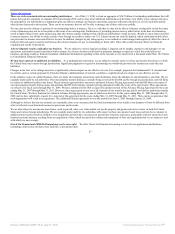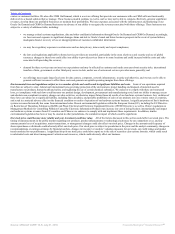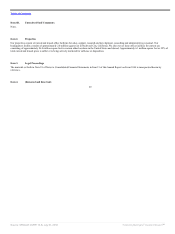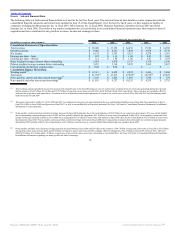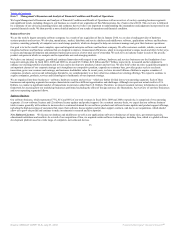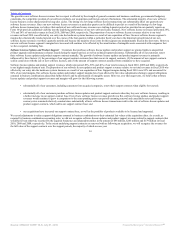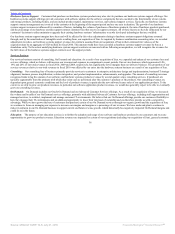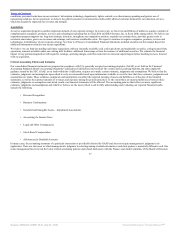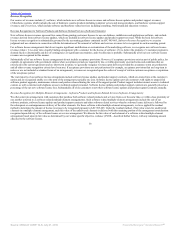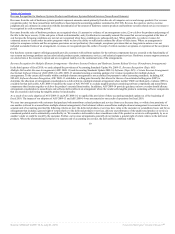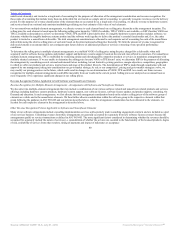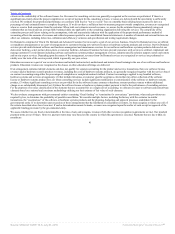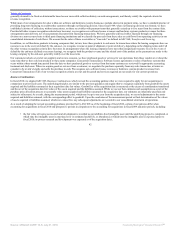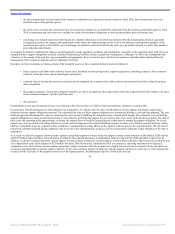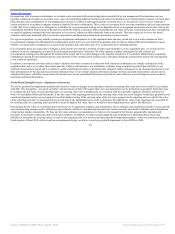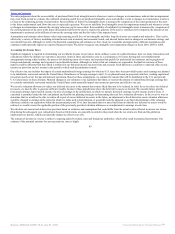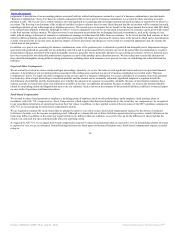Oracle 2009 Annual Report Download - page 41
Download and view the complete annual report
Please find page 41 of the 2009 Oracle annual report below. You can navigate through the pages in the report by either clicking on the pages listed below, or by using the keyword search tool below to find specific information within the annual report.
Table of Contents
conditions, personnel reductions in our customers’ information technology departments, tighter controls over discretionary spending and greater use of
outsourcing solutions. In recent periods, we believe the global economic environment has unfavorably affected customer demand for our education services,
which has negatively impacted our revenues and margins.
Acquisitions
An active acquisition program is another important element of our corporate strategy. In recent years, we have invested billions of dollars to acquire a number of
complementary companies, products, services and technologies including Sun in fiscal 2010 and BEA Systems, Inc. in fiscal 2008, among others. We believe our
acquisition program supports our long-term strategic direction, strengthens our competitive position, expands our customer base, provides greater scale to
accelerate innovation, grows our revenues and earnings, and increases stockholder value. We expect to continue to acquire companies, products, services and
technologies in furtherance of our corporate strategy. See Note 2 of Notes to Consolidated Financial Statements included elsewhere in this Annual Report for
additional information related to our recent acquisitions.
We believe we can fund our pending and future acquisitions with our internally available cash, cash equivalents and marketable securities, cash generated from
operations, amounts available under our existing debt facilities, additional borrowings or from the issuance of additional securities. We estimate the financial
impact of any potential acquisition with regard to earnings, operating margin, cash flow and return on invested capital targets before deciding to move forward
with an acquisition.
Critical Accounting Policies and Estimates
Our consolidated financial statements are prepared in accordance with U.S. generally accepted accounting principles (GAAP) as set forth in the Financial
Accounting Standards Board’s Accounting Standards Codification (Codification) and consider the various staff accounting bulletins and other applicable
guidance issued by the SEC. GAAP, as set forth within the Codification, requires us to make certain estimates, judgments and assumptions. We believe that the
estimates, judgments and assumptions upon which we rely are reasonable based upon information available to us at the time that these estimates, judgments and
assumptions are made. These estimates, judgments and assumptions can affect the reported amounts of assets and liabilities as of the date of the financial
statements as well as the reported amounts of revenues and expenses during the periods presented. To the extent there are material differences between these
estimates, judgments or assumptions and actual results, our financial statements will be affected. The accounting policies that reflect our more significant
estimates, judgments and assumptions and which we believe are the most critical to aid in fully understanding and evaluating our reported financial results
include the following:
• Revenue Recognition
• Business Combinations
• Goodwill and Intangible Assets—Impairment Assessments
• Accounting for Income Taxes
• Legal and Other Contingencies
• Stock-Based Compensation
• Allowances for Doubtful Accounts
In many cases, the accounting treatment of a particular transaction is specifically dictated by GAAP and does not require management’s judgment in its
application. There are also areas in which management’s judgment in selecting among available alternatives would not produce a materially different result. Our
senior management has reviewed the below critical accounting policies and related disclosures with the Finance and Audit Committee of the Board of Directors.
37
Source: ORACLE CORP, 10-K, July 01, 2010 Powered by Morningstar® Document Research℠


